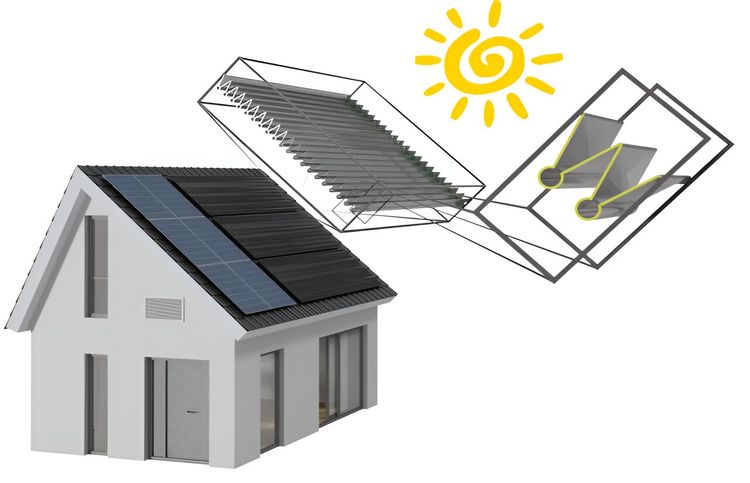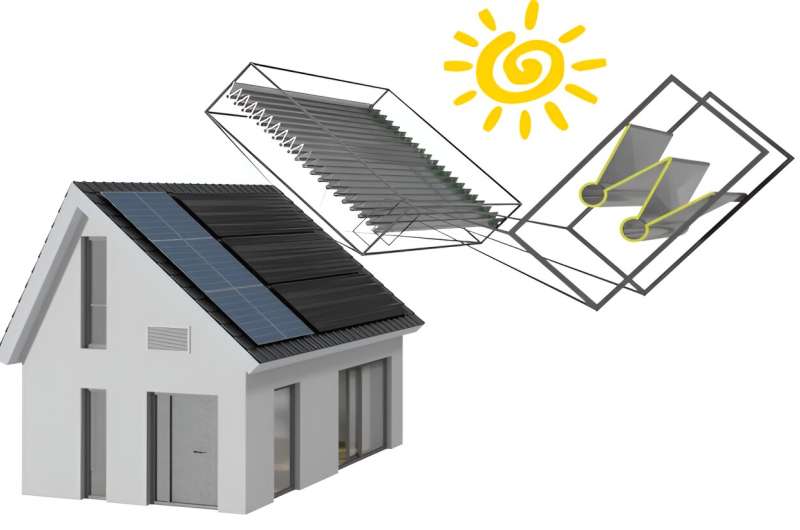New photoreactor technology could pave the way to a carbon-neutral future, researchers say

Image of the photoreactor prototype, suitable for installation on buildings; in the top left-hand corner, we can observe the photoreactor panels; in the top right-hand corner, we can see the V-shaped concentrators and tube-like cavity of the photoreactors. Acknowledgement: University of Toronto

A group of scientists from various countries, which includes experts from the University of Toronto, has formulated and put into practice an innovative blueprint for photoreactors. These solar-powered devices have the ability to transform water, carbon dioxide, methane, and nitrogen into more environmentally friendly chemicals and fuels.
The groundbreaking design enables the photoreactor to efficiently capture photons even when the sun is in different positions, removing the necessity of tracking its movement. Additionally, these panels can be produced using a polymer extrusion method, resulting in a cost-effective and easily scalable manufacturing process. These advantages have the potential to make a sustainable future more accessible and feasible to a wider audience.
Geoffrey Ozin, a professor at the University of Toronto's chemistry department in the Faculty of Arts & Science, joined forces with scientists from the Karlsruhe Institute of Technology (KIT) in Germany for this endeavor.
According to Ozin, solar panels are highly praised for their ability to convert sunlight into clean and affordable electricity, eliminating the need for fossil fuels that emit greenhouse gases.
Contrary to thermoreactors, photoreactors merge sunlight and reactants to produce environmentally friendly chemicals and fuels. Employing sunlight and water allows photoreactors to significantly diminish carbon emissions.
Despite their promise, numerous photoreactors have encountered various obstacles, such as the exorbitant expenses associated with the construction materials. Additionally, their effectiveness in converting photons into desired products can be lacking. Photoreactors heavily rely on a photocatalyst, a substance that absorbs light and transforms a reactant into a product, to facilitate these photochemical conversions.
Nevertheless, unproductive procedures caused by the reflection, dispersion, passage, and assimilation of light by the photocatalyst and photoreactor substances may lead to a reduction in energy. To maximize light collection, sun-tracking would greatly aid photoreactors by incorporating a mechanism that alters the photoreactor's angle according to the sun's position.
In order for photoreactors to be considered technologically and economically feasible, the efficiency in converting photons into products must be a minimum of 10%. Although there have been notable advancements in the past ten years in the field of incorporating photocatalysts into photoreactors to produce environmentally friendly chemicals and fuels, the conversion efficiencies have remained meager, often reaching just one percent or even lower.
Ozin's crew and the KIT squad, comprised of postdoc Paul Kant, PhD candidate Shengzhi Liang, scientist Michael Rubin, and Professor Roland Dittmeyer, crafted a photoreactor resembling a panel, complete with numerous microscale reaction channels running in parallel. The team recently documented their encouraging findings in the esteemed journal Joule.
One important aspect of their design is that every reaction pathway is linked to a light-collecting unit shaped like a "V". This unit is responsible for directing the light into the pathway where the photocatalyst is positioned. All surfaces in the design are extremely reflective, allowing for maximum efficiency in the transfer of photons from the external light source to the photocatalyst housed within the microchannels, with minimal loss of light along the way.
The groundbreaking structure enables the photoreactor to efficiently collect photons from different angles of the sun, eradicating the necessity for tracking the sun's movement. Moreover, the panels can be fabricated using polymer extrusion, thereby ensuring low costs and easy mass production.
Upcoming design changes can tackle the problem of sporadic sunlight by incorporating light-generating diodes into the photoreactor as the source of photons. These diodes will be powered by renewable electricity derived from photovoltaics, and in case of reduced sunlight, a lithium-ion battery will provide backup power to ensure continuous operations around the clock.
The latest photoreactors design has the capability to surpass current cutting-edge photoreactors. It is suitable for installation on rooftops of residential buildings and solar farms. Moreover, it can be seamlessly combined with photovoltaic systems to generate sustainable electricity along with environmentally friendly chemicals and fuels.
According to Ozin, this technological advancement has sparked the creation of a fresh breed of solar-powered gadgets that generate eco-friendly fuels like hydrogen by utilizing sunlight and water.
The progress occurs during a period when addressing climate change is extremely urgent, as this summer has witnessed unprecedented high temperatures across the globe.
KIT researcher Kant states that these solar products will replace their fossil-based counterparts and contribute to the decrease of our carbon footprint.
This significantly boosts the likelihood of achieving our aspirations for a humanity that can live sustainably. It is our hope that we can achieve this without experiencing extreme temperature surpasses and the subsequent catastrophes, and moreover, that we can accomplish it within the allotted timeframe.
Additional details: Paul Kant and collaborators have developed inexpensive photoreactors that are extremely efficient in terms of photon and energy utilization for solar-powered synthesis. This research has been published in the journal Joule, with the assigned DOI number 10.1016/j.joule.2023.05.006.
Reference: According to researchers, a novel photoreactor technology may lead us to a future devoid of carbon emissions, as stated in a recent article published on Phys.org on August 10, 2023, retrieved on August 13, 2023.
This text is protected by copyright. Except for any reasonable use for personal learning or investigation, no part of it can be reproduced without written consent. The content is only provided for informational purposes.

















